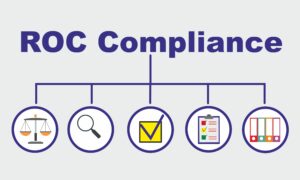ROC Compliance: Ensuring Corporate Governance and Regulatory Compliance
ROC (Registrar of Companies) compliance is a vital aspect of corporate governance that ensures companies adhere to regulatory requirements mandated by the Companies Act, 2013, in India. Compliance with ROC regulations is essential for maintaining transparency, accountability, and legal conformity in corporate operations. Here’s an in-depth look at ROC compliance and its significance:
- Understanding ROC Compliance:
ROC compliance refers to fulfilling statutory obligations and filing necessary documents with the Registrar of Companies as stipulated by the Companies Act, 2013, and other relevant laws and regulations. These obligations include maintaining statutory records, filing annual returns, conducting board meetings, and adhering to corporate governance norms.

- Key Components of ROC Compliance:
1.Annual Filings:
Companies are required to file annual returns, financial statements, and other statutory documents with the ROC within prescribed timelines. These filings provide transparency about the company’s financial health and operations.
2.Maintenance of Statutory Registers:
Companies must maintain various statutory registers, including registers of members, directors, share transfers, and debenture holders, as required by law. These registers serve as crucial records documenting corporate activities and ownership.
3.Conducting Board Meetings:
Companies are obligated to convene board meetings at regular intervals and maintain minutes of such meetings. Board meetings facilitate decision-making and governance oversight, ensuring alignment with corporate objectives and legal requirements.
4.Compliance with Corporate Governance Norms:
Adherence to corporate governance principles, such as the composition of the board, appointment of independent directors, audit committee oversight, and transparency in financial reporting, is essential for ensuring ROC compliance.
5.Filing of Special Resolutions and Notices:
Companies must file special resolutions and notices related to significant corporate actions, such as changes in the company’s capital structure, alteration of memorandum and articles of association, or appointment/removal of directors.
Significance of ROC Compliance:
1.Legal Conformity:
Compliance with ROC regulations ensures that companies operate within the framework of applicable laws and regulations, mitigating the risk of legal liabilities, penalties, and regulatory scrutiny.
2.Enhanced Transparency:
ROC compliance fosters transparency and accountability by providing stakeholders, including shareholders, investors, creditors, and regulatory authorities, with accurate and timely information about the company’s affairs.
3.Investor Confidence:
Demonstrating adherence to regulatory requirements and corporate governance standards enhances investor confidence and trust in the company’s management, potentially attracting investment and fostering long-term relationships with stakeholders.
4.Risk Mitigation:
Effective ROC compliance helps identify and mitigate operational, financial, and regulatory risks, safeguarding the interests of the company and its stakeholders against potential adverse outcomes.
5.Business Continuity:
Non-compliance with ROC regulations can lead to regulatory sanctions, fines, and even the striking off of the company’s name from the register, jeopardizing its ability to conduct business. Ensuring compliance is essential for maintaining business continuity and reputation.
ROC compliance is not merely a legal obligation but a cornerstone of corporate governance and responsible business conduct. By adhering to regulatory requirements, companies uphold transparency, accountability, and integrity in their operations, fostering trust among stakeholders and sustaining long-term growth and success. Prioritizing ROC compliance is indispensable for companies seeking to navigate the dynamic regulatory landscape and thrive in today’s business environment.